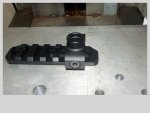I’m coming in here a little late but I thought I’d add a tidbit about the fears of using properly manufactured aluminum push button base. I read some of the previous post and it got me curious so I thought I’d perform a pull test on a GrovTec GTSW-278 rail mount aluminum base using a Chatillon Digital Force Gauge mounted on a test stand which allows linear testing and recording of peak force measurements. The Chatillon gauge is calibrated in accordance to ISO 2001 requirements. The swivel base is made from 6061 aluminum with a Type III hard anodize finish. I got up to 360lbs of tension without any distortion of the rail, base, or swivel. At 404lbs, I pulled the rail through the hold down screw, the base stayed clamped to the rail, and the swivel loop just started to show an ever so slight sign of distortion but the aluminum base was holding the swivel firmly in place. I removed the push button swivel and inspected the ball bearing groove in the base and there were four tiny, shallow dimples where the ball bearings were pulling against the base. But even with the dimples, the base was still fully functional. In short, with the ability to handle that kind of tension, you can use properly manufactured aluminum bases without fear of your rifle becoming a lawn dart and getting free engraving courtesy of rocks and gravel.




